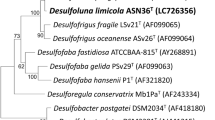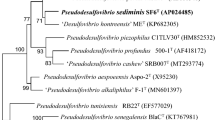Abstract
Aerobic, Gram-stain-negative, obligately chemolithoautotrophic thiosulfate-oxidizing bacteria, strains AkT22T and aks77T were isolated from a brackish lake in Japan. Strains AkT22T and aks77T were isolated from samples of eelgrass and sediment, respectively. Growth on sulfide, tetrathionate, elemental sulfur, and organic substrates was not observed for both strains. Growth of the strains was observed at 5 °C or higher temperature, with optimum growth at 22 °C. Strain AkT22T grew at a pH range of 5.8–8.0, with optimum growth at pH 6.7–7.8. Strain aks77T grew at a pH range of 5.8–8.5, with optimum growth at pH 7.0–7.9. Major cellular fatty acids (> 10% of total) of strain AkT22T were C16:1, C18:1, and C16:0. The sole respiratory quinone was ubiquinone-8 in both strains. The genome of strain AkT22T consisted of a circular chromosome, with size of approximately 2.6 Mbp and G + C content of 43.2%. Those values of the genome of strain aks77T were ca. 2.7 Mbp and 45.5%, respectively. Among cultured bacteria, Thiomicrorhabdus aquaedulcis HaS4T showed the highest sequence identities of the 16S rRNA gene, to strains AkT22T (94%) and aks77T (95%). On the basis of these results, Thiosulfativibrio zosterae gen. nov., sp. nov. and Thiosulfatimonas sediminis gen. nov., sp. nov. are proposed, with type strains of AkT22T (= BCRC 81184T = NBRC 114012T = DSM 109948T) and aks77T (= BCRC 81183T = NBRC 114013T), respectively.


Similar content being viewed by others
References
Bligh EG, Dyer WJ (1959) A rapid method of total lipid extraction and purification. Can J Biochem Physiol 37:911–917
Boden R, Scott KM, Williams J, Russel S, Antonen K et al (2017a) An evaluation of Thiomicrospira, Hydrogenovibrio and Thioalkalimicrobium: reclassification of four species of Thiomicrospira to each Thiomicrorhabdus gen. nov. and Hydrogenovibrio, and reclassification of all four species of Thioalkalimicrobium to Thiomicrospira. Int J Syst Evol Microbiol 67:1140–1151
Boden R, Scott KM, Rae AW, Hutt LP (2017b) Reclassification of Thiomicrospira hydrogeniphila (Watsuji et al. 2016) to Thiomicrorhabdus hydrogenophila comb. nov., with emended description of Thiomicrorhabdus (Boden et al., 2017). Int J Syst Evol Microbiol 67:4205–4209
Brinkhoff T, Muyzer G, Wirsen CO, Kuever J (1999a) Thiomicrospira kuenenii sp. nov. and Thiomicrospira frisia sp. nov., two mesophilic obligately chemolithoautotrophic sulfur-oxidizing bacteria isolated from an intertidal mud flat. Int J Syst Bacteriol 49:385–392
Brinkhoff T, Muyzer G, Wirsen CO, Kuever J (1999b) Thiomicrospira chilensis sp. nov., a mesophilic obligately chemolithoautotrophic sulfur-oxidizing bacterium isolated from a Thioploca mat. Int J Syst Bacteriol 49:875–879
Chaumeil PA, Mussig AJ, Hugenholtz P, Parks DH (2020) GTDB-Tk: a toolkit to classify genomes with the Genome Taxonomy Database. Bioinfomatics 36:1925–1927
Edgar RC (2004) Muscle: multiple sequence alignment with high accuracy and high throughput. Nucleic Acids Res 32:1792–1797
Headd B, Engel AS (2014) Biogeographic congruency among bacterial communities from terrestrial sulfidic springs. Front Microbiol 5:473
Jolley KA, Bliss CM, Bennett JS, Bratcher HB, Brehony C et al (2012) Ribosomal multilocus sequence typing: universal characterization of bacteria from domain to strain. Microbiology 158:1005–1015
Knittel K, Kuever J, Meyerdierks A, Meinke R, Amann R et al (2005) Thiomicrospira arctica sp. nov. and Thiomicrospira psychrophila sp. nov., psychrophilic, obligately chemolithoautotrophic, sulfur-oxidizing bacteria isolated from marine Arctic sediments. Int J Syst Evol Microbiol 55:781–786
Kojima H, Fukui M (2016) Sulfuriflexus mobilis gen. nov., sp. nov., a sulfur-oxidizing bacterium isolated from a brackish lake sediment. Int J Syst Evol Microbiol 66:3515–3518
Kojima H, Fukui M (2019) Thiomicrorhabdus aquaedulcis sp. nov., a sulfur-oxidizing bacterium isolated from lake water. Int J Syst Evol Microbiol 69:2849–2853
Kojima H, Watanabe T, Fukui M (2016) Sulfuricaulis limicola gen. nov., sp. nov., a sulfur oxidizer isolated from a lake. Int J Syst Evol Microbiol 66:266–270
Kumar S, Stecher G, Li M, Knyaz C, Tamura K (2018) MEGA X: molecular evolutionary genetics analysis across computing platforms. Mol Biol Evol 35:1547–1549
Lane DJ (1991) 16S/23S rRNA sequencing. In: Stackebrandt E, Goodfellow M (eds) Nucleic acid techniques in bacterial systematics. Wiley, New York, pp 115–175
Liu X, Jiang L, Hu Q, Lyu J, Shao Z (2020) Thiomicrorhabdus indica sp. nov., an obligately chemolithoautotrophic, sulfur-oxidizing bacterium isolated from a deep-sea hydrothermal vent environment. Int J Syst Evol Microbiol 70:234–239
Minnikin DE, Collins MD, Goodfellow M (1979) Fatty acid and polar lipid composition in the classification of Cellulomonas, Oerskovia and related taxa. J Appl Bacteriol 47:87–95
Parks DH, Chuvochina M, Waite DW, Rinke C, Skarshewski A et al (2018) A standardized bacterial taxonomy based on genome phylogeny substantially revises the tree of life. Nat Biotech 3:996–1004
Qin QL, Xie BB, Zhang XY, Chen XL, Zhou BC et al (2014) A proposed genus boundary for the prokaryotes based on genomic insights. J Bacteriol 196:2210–2215
Tanizawa Y, Fujisawa T, Nakamura Y (2017) DFAST: a flexible prokaryotic genome annotation pipeline for faster genome publication. Bioinformatics 35:1037–1039. https://doi.org/10.1093/bioinformatics/btx713
Watanabe T, Kojima H, Umezawa K, Hori C, Takasuka ET et al (2019) Genomes of neutrophilic sulfur-oxidizing chemolithoautotrophs representing 9 proteobacterial species from 8 genera. Front Microbiol 10:316
Watanabe M, Kojima H, Fukui M (2020) Aerosticca soli gen. nov., sp. nov., an aerobic gammaproteobacterium isolated from crude oil-contaminated soil. Arch Microbiol 202:1069–1076
Watsuji TO, Hada E, Miyazaki M, Ichimura M, Takai K (2016) Thiomicrospira hydrogeniphila sp. nov., a novel aerobic, hydrogen-and sulfur-oxidizing chemolithoautotroph isolated from a seawater tank containing a block of beef tallow. Int J Syst Evol Microbiol 66:3688–3693
Wirth JS, Whitman WB (2018) Phylogenomic analyses of a clade within the roseobacter group suggest taxonomic reassignments of species of the genera Aestuariivita, Citreicella, Loktanella, Nautella, Pelagibaca, Ruegeria, Thalassobius, Thiobacimonas and Tropicibacter, and the proposal of six novel genera. Int J Syst Evol Microbiol 68:2393–2411
Yoon SH, Ha SM, Lim J, Kwon S, Chun J (2017) A large-scale evaluation of algorithms to calculate average nucleotide identity. Antonie Van Leeuwenhoek 110:1281–1286
Acknowledgements
We thank A. Shinohara and K. Umezawa, Hokkaido University, for their technical assistance.
Funding
This work received no specific grant from any funding agency.
Author information
Authors and Affiliations
Corresponding author
Ethics declarations
Conflict of interest
The authors declare that there are no conflicts of interest.
Additional information
Communicated by Erko Stackebrandt.
Publisher's Note
Springer Nature remains neutral with regard to jurisdictional claims in published maps and institutional affiliations.
The GenBank/EMBL/DDBJ accession numbers for the 16S rRNA gene sequences of strains AkT22T and aks77T are LC510548 and LC510549, respectively. The numbers for their complete genomes are AP021888 (AkT22T) and AP021889 (aks77T).
Electronic supplementary material
Below is the link to the electronic supplementary material.
Rights and permissions
About this article
Cite this article
Mochizuki, J., Kojima, H. & Fukui, M. Thiosulfativibrio zosterae gen. nov., sp. nov., and Thiosulfatimonas sediminis gen. nov., sp. nov.. Arch Microbiol 203, 951–957 (2021). https://doi.org/10.1007/s00203-020-02090-9
Received:
Revised:
Accepted:
Published:
Issue Date:
DOI: https://doi.org/10.1007/s00203-020-02090-9




